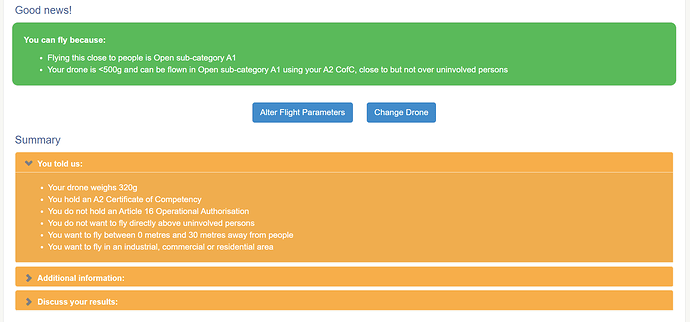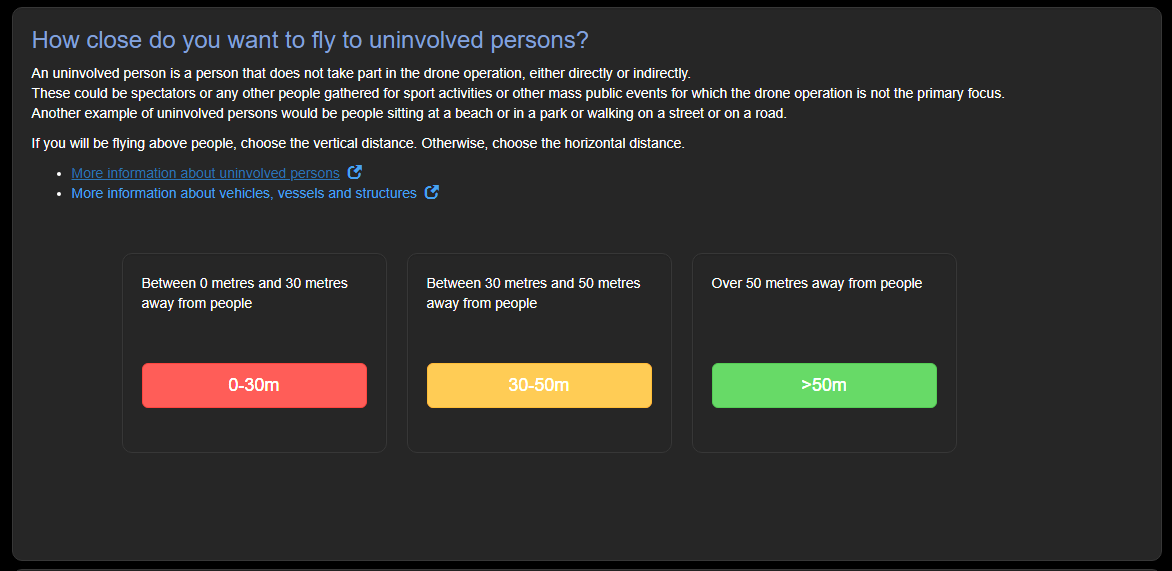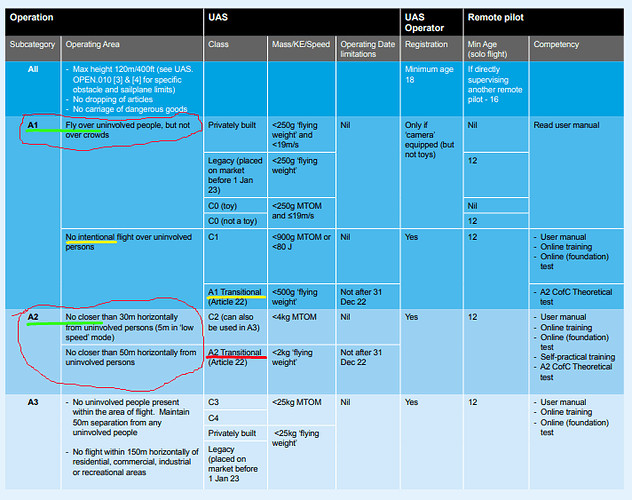Maybe a dumb question but Under article 16 is that if you are a member of FPV
Do you have to make the decision which rules you are flying under ie A2 or Article 16 with a Mini 2 on the day
Regards
Mark
Hi. I’m new to all this and too old (60) for most of it. I have a syma w1 explorer and last summer flew in my garden now I don’t think I’m allowed to do this? Or am I being thick? Some please help
Can’t fly close to people. I don’t know if I put the correct information in. So many people are saying so many things is doing my head in😟 it makes me wonder if it is worth the bother
But that is the whole purpose of Good2Go … you don’t need to listen to others and their possible misinformation.
As to whether you put in the correct information, which questions don’t you know if you answered correctly? … and why?
It says will you be flying close to people. And I don’t know if the bloke nextdoor is going to come out into his garden.
Kev I’m not familiar with your drone but a quick Google search says this drone is 249g in weight. If this is correct you can fly that almost anywhere even from your garden and close to people (within reason)
Hi and thanks for the reply. So my drone is in the sky and the bloke nextdoor comes out onto his garden and as long as I don’t intentionally fly toward him I’m ok?
Pretty much yeah. You can fly over people (but not crowds) and fly near people with no specified separation distance (use of common sense here is advisable). You can fly in any area open countryside, recreational, commercial, industrial and residential areas (including your garden). Just check that your drone definitely weighs less than 250g first as like I say I’m not familiar with your drone and had a quick look on Google for its weight 
Thank you so much it is appreciated.
Hi @Wes. This is what Good 2 Go will display if you tell it your Syma W1 weighs 249g, you want to fly in a residential area (your back garden), and you think it could end up closer than 30m to a neighbour and maybe even fly above them, assuming you have no additional qualifications of any sort:
The yellow bit at the bottom summarises what you could have input in this case. The green bit at the top confirms you are Good 2 Go.
Obviously you still have to fly safely and be careful about privacy etc.
@kvetner - took me a day or two to get back to this but definitely interested to hear anything positive on this…?
Thanks @kvetner
Interesting idea but it seems to need tweaking because it currently says only <250g can fly in A1 when <500g can too if with A2 CofC.
But Flying close to people is Subcategory A2 not A1 (see CAP722 para 2.2.1.2 A1); A1 is flying over people and <500g drones with A2 CofC are permitted. Also, by virtue of being able to fly in Subcategory A1, permission is also granted to fly in Subcategory A2 (close to people) down to 5m (ref CAP722 App A2.2.1). Note also that the limitations for Transitional drones in CAP722 2.2.1.2 A2 refers to A2 Transitional drones, as is confirmed in the Appendices A1.3.2, and not A1 Transitional drones.
Also, why do you use distances of 0m to 30m when CAP722 uses a minimum distance 5m?
I didn’t find the screen you replied with but I did find this, which is wrong for the above reasons…
CAP2012 is your friend on all these queries, and it accurately reflects the regulations themselves, as does Good 2 Go.
This is a misunderstanding. A2 is always flying at least 50m horizontally from people. Flying closer than that in the Open category with a <500g legacy drone always takes place in subcategory A1, not A2, and Good 2 Go reflects that. The heading to CAP722 para 2.2.1.2 A1 is just a heading, and it doesn’t accurately reflect the regulations.
The key requirements for 250-499g legacy drones in the transitional period are in Article 22 of the regulations, which make clear that these can be flown in a limited version of subcategory A1 (not overhead) if an A2 CofC is held.
Good 2 Go’s results reflect that precisely.
This is also a misconception. Anything that can fly in Subcategory A1 can fly right up next to people with no minimum separation distance. The 5m is of no relevance to drones flown in A1, whether in the <250g range or the 250-499g range. Indeed, the 5m only applies to C-class drones flown in subcategory A2 in low-speed mode, and Good 2 Go does not cover those on the grounds that none currently exist.
See the footnote to CAP722 2.2.1.2 A1 which talks about A1 transitional drones. There are three types of transitional drones defined in Article 22 of the regulations: sub-500g drones flown in the limited subcategory A1 (not overhead) using an A2 CofC; sub-2kg drones flown in standard subcategory A2 using an A2 CofC; and sub-25kg drones flown in subcategory A3. The last of those is essentially irrelevant because Article 20 of the same regs allows sub-25kg legacy drones to fly in A3 indefinitely anyway. The first two of those are properly covered by Good 2 Go.
The 5m distance is, as noted above, irrelevant to legacy drones. It only applies to C-class drones that don’t yet exist. Good 2 Go uses the 0-30m distance because 30m is the boundary at which the Article 16 Operational Authorisation kicks in. At distances less than 30m, it will only ever give a “good news” answer for sub-250g drones (flying in standard subcategory A1) or for 250-499g drones accompanied by an A2 CofC (flying in the transitional variant of A1, not overhead).
I hope all that is clear, I would note that it took a lot of time to disentangle all this to build the tool!
Indeed it CAP2012 clearly does show the rules and exactly how Good 2 Go is wrong! A1 is FLYING OVER PEOPLE. A1 Transitional drone may unintentionally fly over them. They may also fly closer with nil separation (although CAP722 details this as 5m). For the accurate wording you need to read CAP722, and I’ve even detailed the references in my previous explanations that you seem to want to ignore. Here’s CAP2012 with the pertinent areas underlined (Also note that the minimum Remote Pilot age has subsequently been removed by CAA recently).
A1 subcategory is, as your extract above shows, really two different things: C0 and sub-250g drones that can be flown next to and above uninvolved people; and C1 and A1 transitional drones that can be flown next to and only unintentionally over uninvolved people.
Are you simply asking that we make it clear that for A1 Transitional drones they can also overfly if it is unintentional? Good 2 Go currently takes the approach that if the users says they do plan to fly such a drone overhead, it gives a “bad news” result.
You previously quoted CAP722 A2.2.1 as backing up the view that there is a 5m separation required for A1 transitional drones, but it says nothing about 5m separation and it’s the section for drones flying in A2. There is no 5m separation distance for drones flown in any flavour of A1. Once you establish that a drone can be flown in either flavour of A1, everything about A2 becomes irrelevant.
No need to be rude - I read them and I stated where I think you are misreading them. I’m more than happy to continue the discussion if you’re happy to be civil.
Hi Kvetner,
Firstly, I would like to apologise if I appeared rude. That was not my intention and I appreciate the effort that you have put in to this project. It is without doubt a potentially very useful tool.
What you say about the 5m distance is also true. Entitlement to flying in subcategory A1 is automtic acceptance for flying in A2 but this condition is not followed in your program.
When I tried your program, with <500g drone and A2 CofC, it first produced a screen with just two options, fly over people or not. I may fly in areas where people might walk beneath my path and this would be unintentional, so there needs to be a third option.
The next screen I encountered (shown in a previous message above) gave a red light to flying 0 to 30m, amber for 30m to 50m, and green thereafter. This is clearly wrong because based on my entry details the lights should have been green for all three scenarios as I am entitled to fly in subcategory A1.
Having said all of this, I still think your idea is extremely useful. I just think it needs tweaking.
Paul




